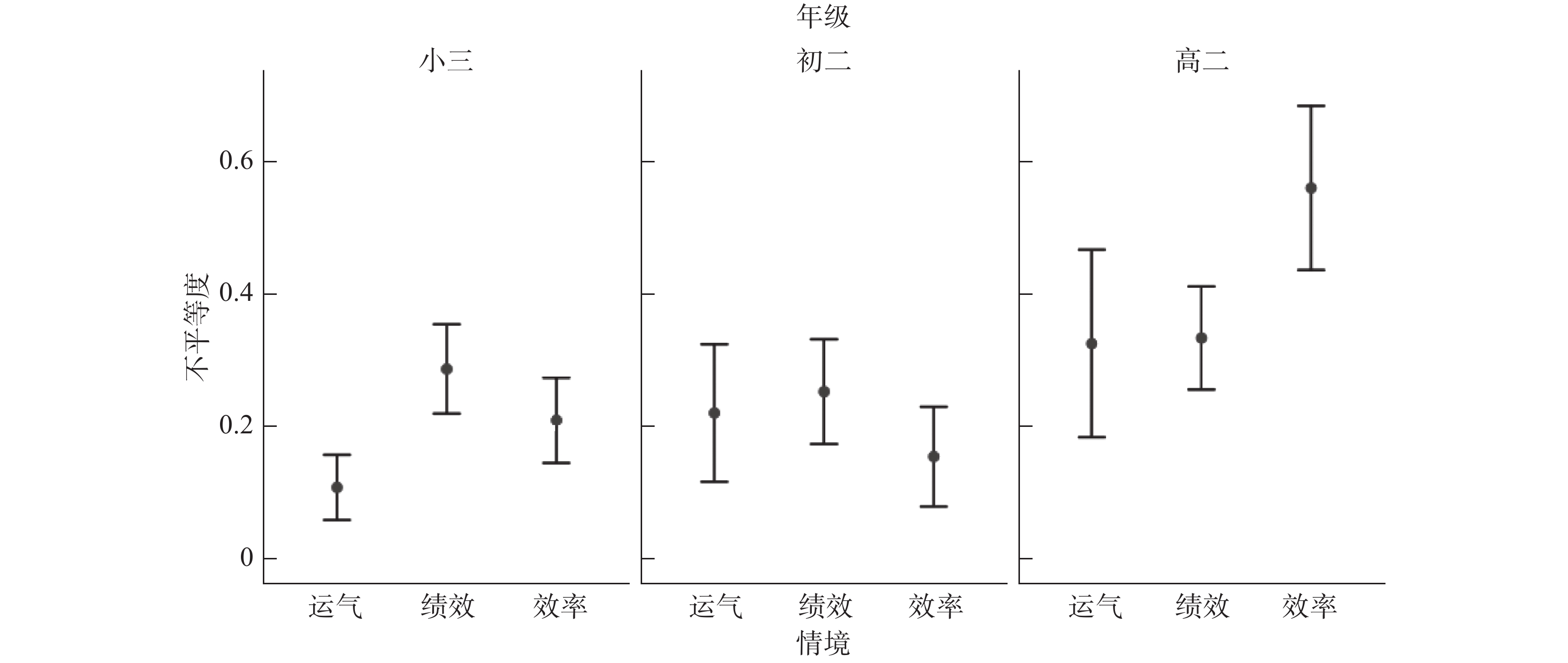What is Equity from Students’ Perspective: Evidence from the Experiment Research
-
摘要: 本文运用实验研究的方法,通过利益相关者和旁观者游戏,对小学、初中和高中不同年龄阶段的667名学生的公平偏好进行实验研究,探索学生眼中的公平观,分析学生公平偏好的影响因素。研究发现,中小学不同年龄学生的公平偏好是发展性的,学生最初倾向于均等主义的公平观,随着年龄的增长以及受到同伴关系、认知发展、社会经验等因素的影响,学生越来越倾向于接受由运气、绩效和效率导致的不平等,体现了差异化的公平观。家庭背景与学校教育在塑造儿童公平偏好过程中均起到重要的作用。家长的学历和教育水平会影响儿童的公平偏好,父母学历越高,学生越容易接受由运气导致的不平等分配。中国比较独特的班干部制度的育人价值不仅体现在班级管理与领导力提升等方面,也体现在塑造儿童不同的公平偏好上。因此教育者在不同的年级针对不同年龄的学生要考虑到不同的公平策略。Abstract: The purpose of this study is to explore the developmental levels of students’ equity preferences and influence factors by using stakeholder and spectator game in experimental economic. The result shows that student’s equity preferences change with age, peer relationship, cognition and social experience, from egalitarianism to meritocratism and efficiency. Students can accept more and more inequity allocation based on luck, merit and efficiency difference. Family background and schooling are important factors to impact students' equity preferences. The implication of this study is that educators should consider the different educational equity strategies for different students of ages in schools and families.
-
Key words:
- equity preference /
- students /
- experimental economic /
- stakeholder game /
- spectator game
-
表 1 主要变量的描述性统计
9岁(小三) 13岁(初二) 17岁(高二) N 描述数据 N 描述数据 N 描述数据 性别 262 男生占51% 136 男生占48% 145 男生占40% 少数民族 262 少数民族占5% 136 少数民族占2% 145 少数民族占4% 独生子女 262 独生子女占68% 136 独生子女占68% 145 独生子女占92% 上海户口 262 上海户口占99% 136 上海户口占90% 145 上海户口占97% 班干部 262 班干部占42% 136 班干部占43% 145 班干部占51% 收入 262 M=2.47 SD=0.80 136 M=2.07 SD=0.83 145 M=1.91 SD=0.74 父母学历 262 M=7.66 SD=1.62 136 M=5.99 SD=1.97 145 M=6.12 SD=1.90 表 2 回归分析结果
利益相关 运气 绩效 效率 初二 −0.10** −0.09* 0.11 0.15* −0.03 −0.04 −0.05 −0.05 (0.03) (0.03) (0.06) (0.06) (0.06) (0.06) (0.06) (0.06) 高二 −0.01 0.01 0.22* 0.22* 0.05 0.05 0.35* 0.36* (0.03) (0.03) (0.06) (0.07) (0.05) (0.06) (0.06) (0.06) 性别 0.07 −0.01 0.02 0.06 (0.03) (0.05) (0.05) (0.05) 少数民族 0.03 −0.01 0.18 −0.04 (0.06) (0.10) (0.15) (0.13) 独生子女 0.00 0.09 0.05 −0.03 (0.03) (0.06) (0.05) (0.06) 上海户口 0.05 −0.22 −0.02 0.09 (0.07) (0.14) (0.12) (0.13) 班干部 0.02 −0.04 −0.11* −0.04 (0.03) (0.05) (0.05) (0.05) 收入 0.02 −0.03 0.03 0.02 (0.02) (0.04) (0.03) (0.03) 父母学历 0.00 0.03* −0.01 −0.01 (0.01) (0.01) (0.01) (0.02) 常数 0.17** −0.02 0.11** 0.14 0.29** 0.17 0.21** 0.17 (0.02) (0.11) (0.03) (0.23) (0.03) (0.20) (0.03) (0.22) 观察数 543 543 172 172 170 170 198 198 R方 0.02 0.04 0.07 0.13 0.01 0.07 0.19 0.20 注:p<0.05标注为*,p<0.01标注为**。 -
[1] 陈童, 伍珍. (2017). 儿童的分配公平性: 心理理论的作用. 心理科学进展,25(08),1299—1309. [2] 罗尔斯. (2001). 正义论(何怀宏 等译). 北京: 中国社会科学出版社. [3] 桑德尔. (2011). 公正(朱慧玲 译). 北京: 中信出版社. [4] 苏彦捷, 张慧, 张康. (2012). 社会决策: 自我利益与他人利益的权衡. 心理科学,35(06),1423—1428. [5] Almås, I., Cappelen, A. W., Salvanes, K. G., Sorensen, E., Tungodden, B. (2017). Fairness and Family Background. Politics Philosophy & Economics, 16(2), 117—131. [6] Almås, I., Cappelen, A. W., & Tungodden, B. (2016). Cutthroat Capitalism Versus Cuddly Socialism: Are Americans More Meritocratic and Efficiency-Seeking than Scandinavians? SSRN Electronic Journal. http://doi.org/10.2139/ssrn.2879358. [7] Almås, I., Cappelen, A. W., Sorenson, E., Tungodden, B. (2010). Fairness and the development of inequality acceptance. Science, 328(5982), 1176—1178. doi: 10.1126/science.1187300 [8] Andreoni, J., & Bernheim, B. D. (2010). Social image and the 50-50 norm: a theoretical and experimental analysis of audience effects. Econometrica, 77(5), 1607—1636. [9] Banerjee, R. (2002). Audience effects on self-presentation in childhood. Review of Social Development, 11(4), 487—507. doi: 10.1111/1467-9507.00212 [10] Benensona, J. F. Pascoe, J., Radmore. N. (2007). Children’s altruistic behavior in the dictator game. Evolution and Human Behavior, 28, 168—175. doi: 10.1016/j.evolhumbehav.2006.10.003 [11] Blake, P. R., Rand. D.G. (2010). Currency value moderates equity preference among young children. Evolution & Human Behavior, 31(3), 210—218. [12] Bolton, G. E., & Ockenfels, A. (2000). ERC: A theory of equity, reciprocity, and competition. The American Economic Review, 90, 166—193. doi: 10.1257/aer.90.1.166 [13] Cappelen, A. W., List, J. A., Samek, A., & Tungodden, B. (2016). The effect of early education on social preferences (No. w22898). National Bureau of Economic Research. [14] Dana, J., Weber, R. A., & Kuang, J. X. (2007). Exploiting moral wiggle room: experiments demonstrating an illusory preference for fairness. Economic Theory, 33(1), 67—80. doi: 10.1007/s00199-006-0153-z [15] Engelmann, Jan & Tomasello, Michael. (2019). Children’s Sense of Fairness as Equal Respect. Trends in Cognitive Sciences. 23. 10.1016/j.tics.2019.03.001. [16] Fehr, E., Bernhard, H. & Rockenbach, B. (2008). Egalitarianism in young children. Nature, 454(7208), 1079—1083. doi: 10.1038/nature07155 [17] Fehr, E., & Schmidt, K. M. (1999). A theory of fairness, competition, and cooperation. Quarterly Journal of Economics, 114, 817—868. doi: 10.1162/003355399556151 [18] Guo, X. (2013). Increased Neural Responses to Unfairness in a Loss Context. NeuroImage, 77, 246—253. doi: 10.1016/j.neuroimage.2013.03.048 [19] Kogut, T. (2012). Knowing what I should. doing what I want: From selfishness to inequity aversion in young children's sharing behavior. Journal of Economic Psychology, 33, 226—236. doi: 10.1016/j.joep.2011.10.003 [20] Levitt, S. D., & List, J. A. (2007). What do laboratory experiments measuring social preferences reveal about the real world?. Journal of Economic Perspectives, 21(2), 153—174. doi: 10.1257/jep.21.2.153 [21] Rilling, J. K. & Sanfey, A.G. (2011). The neuroscience of social decision-making. Annual Review of Psychology, 62, 23—48. doi: 10.1146/annurev.psych.121208.131647 [22] Rochat P, Dias MDG, Liping G, Broesch T, Passos-Ferreira C, et al. (2009). Fairness in distributive justice by 3- and 5-year-olds across 7 cultures. J Cross Cult Psychol, 40, 416—442. doi: 10.1177/0022022109332844 [23] Rutland, A., & Killen, M. (2017). Fair resource allocation among children and adolescents: the role of group and developmental processes. Child Development Perspectives, 11(1), 56—62. doi: 10.1111/cdep.12211 [24] Shaw, A., Montinari, N., Piovesan, M., Olson, K. R., Gino, F., & Norton, M. I. (2014). Children develop a veil of fairness. J Exp Psychol Gen, 143(1), 363—375. doi: 10.1037/a0031247 [25] Sun, Q., Liu, Y., Zhang, H., and Lu, J. (2016). Increased social distance makes people more risk neutral. J. Soc. Psychol., 157, 502—512. doi: 10.1080/00224545.2016.1242471 [26] Yu, J., Zhu, L., & Leslie, A. M. (2016). Children's sharing behavior in mini-dictator games: the role of in-group favoritism and theory of mind. Child Development, 87(6), 1747—1757. doi: 10.1111/cdev.12635 -






 下载:
下载:

